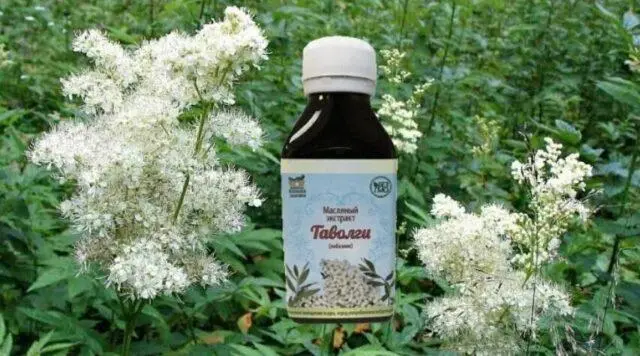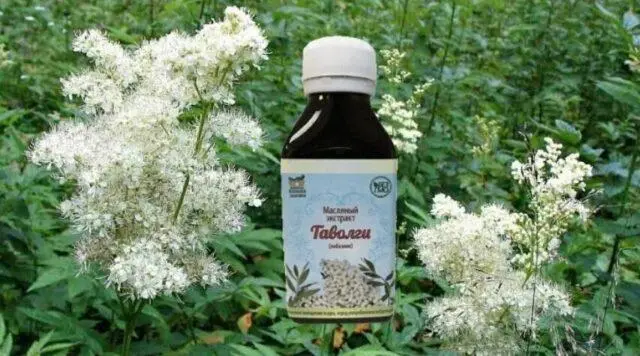Contents
The medicinal properties of meadowsweet oil are well known in folk medicine. The drug is used as a “remedy for 40 diseases”, which already suggests its inefficiency. Official medicine does not know about such a medicine. Meadowsweet hydrolat can be found commercially as a fragrance. The manufacturer on the label often indicates that the drug is not a medicine, disclaiming responsibility for its use for medicinal purposes. This is justified. It is enough to take a closer look at the chemical composition of preparations from the meadowsweet.
The chemical composition of the oil
On sale you can find hydrolat and oil extract of the meadowsweet. In the people both means are called oil. But this is not entirely correct. The chemical composition and therapeutic efficacy are also different. The medicinal properties of meadowsweet oil and contraindications for its use are due to its chemical composition, the main components of which are poisonous:
- Methyl salicylate: Especially poisonous if ingested. The extract from flowers contains about 28% of the substance, from seeds – about 11%.
- Salicylic aldehyde: toxic in high doses, it is a raw material for the production of salicylic acid. In the preparation from flowers, 2,8% aldehyde, from seeds – 12,4%. Main applications: in the production of dyes, perfumes, as a fungicide and other non-medical industries.
But these same substances have analgesic and anti-inflammatory effects, so they are well suited for external use.
Other components that make up the “essential oil” of the meadowsweet:
- phenol glycosides;
- ionol;
- catechins;
- flavonoids;
- α-terpineol;
- tannins;
- vitamin C;
- fatty acid;
- tannins;
- coumarins;
- essential and aromatic compounds;
- camphor.
Meadowsweet hydrosol can be used externally in the form of compresses and rubbing. It has a pleasant smell. Oil extract is more often used for internal use, since the concentration of active substances in it is not so high.

Flowers and leaves are used to make meadowsweet hydrosol.
Medicinal properties and scope of meadowsweet oil
Traditional healers use meadowsweet oil to treat very different diseases:
- diabetes mellitus;
- organs of the respiratory system: with pneumonia, bronchitis, asthma;
- hypertension;
- diseases of the gastrointestinal tract: spasms or atony of the intestine (these are opposite phenomena), diarrhea, dysentery, gastritis and ulcers;
- epilepsy;
- skin diseases: festering wounds, diaper rash, psoriasis, boils;
- hepatitis A;
- inflammation of large nerves;
- migraine;
- ARVI;
- diseases of the female reproductive system, vaginitis, vulvitis and even infertility, however, in the latter case, the oil acts as an auxiliary component;
- arthritis and arthrosis;
- inflammation in the organs of the genitourinary system;
- helminth invasion.
A very wide spread of diseases indicates the low effectiveness of the oil of the meadowsweet. But it does have a slight analgesic effect and is able to destroy bacteria.
How to make your own butter
In industry, meadowsweet hydrosol with the maximum concentration of substances is obtained from flowers by steam distillation. At home, this method cannot be used. You can only prepare an extract based on refined vegetable oil on your own:
- pour the collected flowers into a glass jar, leaving a little space to the top edge;
- pour raw materials with sunflower, olive or corn oil;
- heat in a water bath without bringing to a boil;
- cool, close the lid and put in a dark and warm place for infusion;
- After two weeks, strain the contents of the jar and pour the liquid into another container.
As a result of all manipulations, an extract from the flowers of the meadowsweet based on vegetable oil should be obtained. In pharmacies and stores, you can most often find just such a drug.

Oil extract is less dangerous when taken orally than meadowsweet hydrolate
How to use
When taken orally, the benefits of natural meadowsweet oil are questionable, and the harm can be much greater than we would like. The main components of the drug, manufactured in an industrial way, are too poisonous. A teaspoon once a day for a month can be a ticking time bomb.
But when it comes to “homemade meadowsweet oil”, the requirements are less strict. The main component of such a drug is ordinary refined vegetable oil. Meadowsweet substances are found there in relatively small quantities. Harmful effects are likely to be mild diarrhea. And “responsible” for this will be vegetable oil.
Homemade extract from the meadowsweet is taken with a meal, a teaspoon once a day. The course of admission is 30 days. Then they take a break for a month.
Since the remedy can cause excessive sweating, it is best taken at night. Or calculate the time so that after using the drug to stay at home for another hour.
Smarter ways to use meadowsweet oil involve a much lower dose:
- ingestion: ten drops once a day, a course of a month;
- for bath: 10-15 drops in warm water;
- for inhalation: 3-4 drops in an inhaler or aroma lamp.
With this dosage, you can use the hydrolat of the meadowsweet, manufactured in an industrial way.
Contraindications and possible harm
No contraindications have been identified for external use of the oil. If there is no allergic reaction. But this is individual.
With internal use, the contraindications are much greater. This is natural for toxic substances. Meadowsweet oil should not be used:
- hypotonic;
- pregnant women;
- people with thrombocytopenia, that is, a low platelet count;
- people with a tendency to constipation.
If these nuances are not taken into account, a factory-made tool will do more harm than good. It can thin the blood. The astringents contained in the meadowsweet relieve diarrhea but aggravate constipation.
Conclusion
The medicinal properties of meadowsweet oil are highly likely to be greatly exaggerated. In any case, before you start taking it, you should consult your doctor. Perhaps this drug will not only not bring benefits, but also cause harm.









